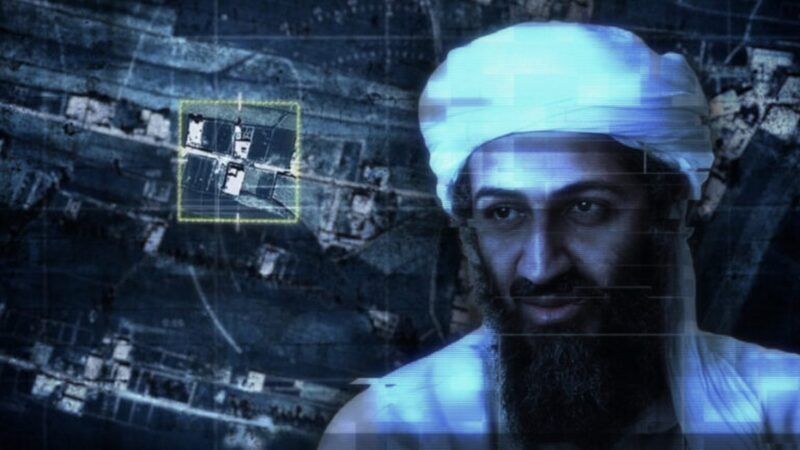Documentary on CIA's Hunt for Bin Laden Doesn't Truly Pull Back the Curtain
As the 20th anniversary of 9/11 approaches, prepare for the many, many looks back.

CIA vs. Bin Laden: First In. Reelz. Sunday, September 5, 8 p.m.
As the 20th anniversary of the Sept. 11th attack approaches, there are at least a dozen TV specials available to watch, of varying merits. Here's one reason you might want to take a look at—CIA vs. Bin Laden: First In, the Reelz cable channel's documentary offering. Mike Morell, a former senior CIA official, is recounting how the agency was zeroing in on a compound in Pakistan where it suspected that Osama bin Laden was hiding out.
The CIA was intrigued by a tall figure its spy flights spotted walking briskly around the compound grounds, a man who the spooks called The Pacer—because they couldn't figure out who he really was; his face was always carefully shielded from view. Bin Laden was known to be 6-foot-5; Morell wondered if the vast U.S. counterterrorism empire that had mushroomed in the wake of 9/11 might be able to get a fix on The Pacer's exact height. The National Geospatial Intelligence Agency was duly invited to examine the CIA's tapes of The Pacer, and proudly reported back to Morell that its photo analysts had established that the mysterious man was "somewhere between five and seven feet tall."
That wasn't much help with bin Laden, but it certainly offers an interesting new perspective on the Cuban Missile Crisis, when John F. Kennedy and his national security cowboys nearly took us to into a shootout with the Soviet Union after that same National Geospatial Intelligence Agency (then operating under the name National Photographic Interpretation Center) identified a bunch of shadowy objects in reconnaissance photos of Cuba as Russian missile launch pads. (By the way, if you, too, can guess a guy's height within a two-foot margin of error, they're hiring.)
It's the occasional odd anecdote like that one, coupled with a taut, dramatic construction, that make CIA vs. Bin Laden something more than a rehash of decades-old news. There's the former head of the CIA operations directorate admitting—maybe a better word is bragging—that the Navy SEALs who broke into bin Laden's compound (yes, the same one where The Pacer took his lonely walks) were bent on not capture but murder. "If we brought him to the United States, he would lawyer up," says the CIA official. "Our interest was not in building a case so we could charge him with a crime. Our interest was to prevent another major attack on the United States." Or the phone call the CIA intercepted from the house moments before the SEALs' chopper arrived, the voice not identifiable, but the message as clear as death: "They've come from above."
These details are related matter-of-factly in on-camera interviews with top officials of the West's leading intelligence agencies, including the CIA, France's DGSE and Great Britain's MI-6. Even in a world where intelligence officials are increasingly disposed to give us a peek inside through memoirs and TV documentaries, it's startling to watch a CIA boss confirm how an al-Qaeda triple agent faked his way into an agency compound with a suicide bomb that blew seven top American spies to bits.
Not that the spooks tell all. There is, for instance, not a word about how the CIA finally became convinced that they'd located bin Laden's Pakistan hideout. For a decade, the common wisdom has been that the agency set up a fake door-to-door inoculation program to collect DNA from the occupants of the house, but Morell curtly dismisses any questions along those lines: "I can't talk about that."
Perhaps some tradecraft issue still makes it impossible for the CIA to discuss that. But other omissions seem to be more a product of the desire to cover agency asses. Though some of the officials interviewed in the show say, truthfully, that the CIA had been hunting bin Laden for years before 9/11, none of them mention that the members of that unit were regarded as paranoid whack jobs who emptied rooms instantly at headquarters in Langley when they made the rounds warning that nobody outside their group was taking al-Qaeda seriously. They were such pariahs that they took to calling themselves "the Manson Family."
Not everybody interviewed in CIA vs. Bin Laden is a spy. Washington Post reporter Joby Warrick, author of three books on the war on terror, offers bits and pieces to keep the narrative on track, including the description of the raucous football-style rally outside the White House after the announcement of bin Laden's death. At last, Warrick declares, "there had been a concluding chapter to this terrible event in American history." As we saw in televised scenes from the Kabul airport last week, not quite.


Show Comments (15)